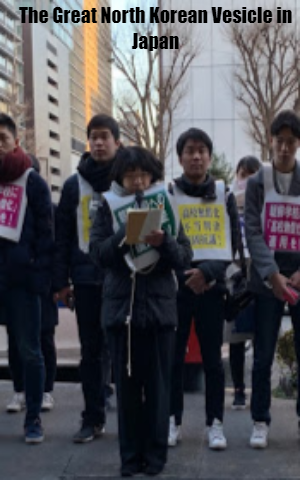The Great North Korean Vesicle in Japan
The Great North Korean Vesicle in Japan


Although nationality means a legal identification of a person as a subject or a national of a sovereign state, from a macro perspective it merely cannot be limited within the boundaries of political, geographical borders, or passport ownership. Rather it is more about ethnocentrism. Here in the following piece, I am going to tell you about the North Korean community in Japan. Who although being it're nationals for decades, had created a separate cultural bubble based on their Korean identity-forming the two major Korean ethnic enclaves known as The Mindan and The Chongryon. Before further discussions on these enclaves, first, we need have to go back to history to get to know about the Korean people in Japan.
In the year 1910, the Korean peninsula got annexed by the Japanese. At that time almost tens of thousands Korean people were captivated as human labor and brought to Japan. Korean men were appointed at the Japanese military and in various factories as workers and Korean women were made sex slaves of the Japanese military personnel. For decades they were vituperatively oppressed and tortured by the Japanese, both physically and mentally which created among them a deep sense of detestation for the native Japanese (now their fellow nationals). After three and a half decades of oppression, these Koreans led to set free to go back to their homeland in the year 1945, after the heavy defeat of the Japanese in the second world war which also resulted in to lose their annexed states of Asia in the south-eastern arena. Setting the Koreans free, resulting in the formation of Associations of Koreans in Japan in the same year for aiding the Korean populace heading back to their native land. Thousands returned within the next five years, but with the outbreak of the Korean War in the year 1950 resulted in the stoppage of the movement and many people decided to stay back in Japan, and here starts the main story, as the scenario doesn’t remain the same further.
The Korean People who stayed back in Japan, now could no longer just remain with their Unified Korean identity as the war resulted in a fraction of Korea, the North backed by the Soviets and the South backed by the USA hence they had to choose from which one they are affiliated with both in case of ideology and heredity. It's noticed, that most of them are of North Korean background and they supported the socialist ideals of the North Korean regime under Kim Il Sung while very few are in support of South Korea this resulted in the fraction of two separate groups within the “Associations of Koreans in Japan” The people who shared North Korean Socialist values influenced by the traditional Juche system formed their separate enclave which is known as The Chongryon in the year 1955 whilst the pro south Korean formed the Mindan, later on, Mindan slowly lost its importance and naturalized themselves as Japanese nationals while the prior stayed in prominence till now and played a significant role, running a kind of separate state in Japan. The Chongryon set up several elementary schools, universities and taught North Korean ideologies of nationalism and socialism and annually planned for a pilgrimage tour to North Korea it is said that the regime of DPRK made generous donations for the enhancement of these institutions. The Chongryon schools get criticized as they don’t follow the Japanese curriculum and keep allegiance to the North Korean Supreme leaders and hence the Japanese Government stopped funding these institutions citing article 89 of the Japanese constitution according to which the use of public funds are restricted by “schemes not under public control”. These resulted in a deep sense of resentment among the Chongryon community. According to Japan’s School Education Act, they considered autonomous, self-funded, miscellaneous schools. Besides setting up academic institutions, they have also set up their own cultural and economic institutions such as sports teams, banks, and insurance companies.
The Chongryon are also key players in Japan’s informal economy, such as Pachinko parlors (where arcade and gambling activities took place) which produced billions of dollars as revenue. From various official documents, we get to know that during their heydays at around 80s-90s, they made a fortune at around 25 billion dollars from where they allegedly sent some money as remittance to N Korea. But slowly things got bad for them as several incidents came out on media that many Japanese nationals were being kidnapped from the Japanese coastal areas allegedly by the North Korean “spies” later on the N Korean regime also officially admitted that, they were engaged in some of the kidnapping activities, further, it went worse when North Korea started its long-range nuclear ballistic missile programs and removed its name from the Nuclear non- proliferation treaty in the year 2003 this led to a series of violent attacks upon the Korean community in Japan out of mass hysteria, the Japanese started to think that due to the beguiling donations sent by the Chongryon to the Kim regime back in DPRK they could proliferate their Nukes setting a constant threat to Japan, but the fact is that presently, even donations from DPRK’s regime has dried up which resulted in the economic and social disillusionment of the community. Many of their institutions like, banks and schools are also set to close due to lack of funding, some of them were even seized by the Japanese Government for national security reasons, but even after that it's quite astounding that they still pay homage to their ancestral land and it’s rulers even after three generations. Which raises the question, "Why do they still can’t share the Japanese identity?"
This is simply because of their historical exploitation by the Japanese which set their life hard to live and created a deep sense of alienness from the Japanese values. These correctly show how borders are made up of culture, language, history, and ideology which exists as much as in our minds as they do on maps.


















































